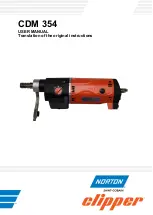
21
EngLIsh
Mechanical Clutch
These tools are fitted with a mechanical clutch. The indication
that the clutch has activated will be an audible ratcheting
together with increased vibration.
Active Vibration Control
For best vibration control, hold the tool as described in
Proper
Hand Position.
The active vibration control neutralises rebound vibration from
the hammer mechanism. Lowering hand and arm vibration,
it allows more comfortable use for longer periods of time and
extends the life of the unit.
The hammer only needs enough pressure to engage the active
vibraton control. Applying too much pressure will not make
the tool drill or chip faster and active vibration control will
not engage.
ASSEMBLY AND ADJUSTMENTS
WARNING: To reduce the risk of serious personal
injury, turn tool off and disconnect tool from power
source before making any adjustments or removing/
installing attachments or accessories.
Be sure the
trigger switch is in the OFF position. An accidental start-up
can cause injury.
Side Handle (Fig. B)
WARNING:
To reduce the risk of personal injury,
ALWAYS
operate the tool with the side handle properly installed.
Failure to do so may result in the side handle slipping
during tool operation and subsequent loss of control. Hold
tool with both hands to maximize control.
The side handle
5
clamps to the front of the gear case and
may be rotated 360˚ to permit right- or left-hand use. The side
handle must be tightened sufficiently to resist the twisting
action of the tool if the accessory binds or stalls. Be sure to grip
the side handle at the far end to control the tool during a stall.
To loosen side handle, rotate counterclockwise.
To Adjust the Depth Rod (Fig. A, B)
1. Push in and hold the depth rod release button
10
on the
side handle.
2. Move the depth rod
9
so the distance between the
end of the rod and the end of the bit equals the desired
drilling depth.
3. Release the button to lock rod into position. When drilling
with the depth rod, stop when end of rod reaches surface
of material.
Bit and Bit Holder
WARNING:
Burn Hazard.
ALWAYS
wear gloves when
changing bits. Accessible metal parts on the tool and bits
may get extremely hot during operation. Small bits of
broken material may damage bare hands.
The hammerdrill can be fitted with different bits depending on
the desired application.
Use sharp drill bits only.
Bit Reccomendations
• For wood, use twist bits, spade bits, power auger bits or
hole saws.
• For metal, use high-speed steel twist drill bits or hole saws.
Use a cutting lubricant when drilling metals. The exceptions
are cast iron and brass which should be drilled dry.
• For masonry, such as brick, cement, cinder block, etc., use
carbide-tipped bits rated for percussion drilling.
SDS-Plus Bit Holder (Fig. C)
nOtE:
Special adapters are needed to use the SDS-plus tool
holder with straight shank bits and hexagonal screwdriver bits.
Refer to
Optional Accessories
.
to insert a drill bit or other accessory:
1. Insert the shank of the bit about 19 mm into SDS-Plus
tool holder.
2. Push and rotate bit until it locks in place. The bit will be
securely held.
3. To release bit, pull the sleeve
8
back and remove the bit.
Keyless Chuck (Fig. C, D)
D25334
On some models, a keyless chuck can be installed in place of the
SDS-Plus bit holder.
WARNING:
Never use standard chucks in the rotary
hammering mode.
Replacing the sDs-Plus Bit holder with the keyless chuck
1. Select hammering only mode (see
Operation Modes
), this
locks the spindle to prevent it from rotating when unlocking
the removable tool holder.
2. Turn the locking collar
11
into the unlocked position and
pull the installed bit holder off.
3. Push the keyless chuck
12
onto the spindle
13
and turn
the locking collar into the locking position.
4. To replace the keyless chuck with the SDS-Plus bit holder,
first remove the keyless chuck the same way as the SDS-
Plus bit holder was removed. Then replace the SDS-Plus
bit holder the same way as the keyless chuck was replaced.
to insert a drill bit or other accessory in keyless chuck:
1. Grasp the sleeve
8
of the chuck with one hand and use the
other hand grasping the base of the chuck.
2. Rotate the sleeve counterclockwise (as viewed from the
front) far enough to accept the desired accessory.
3. Insert the accessory about 19 mm into the chuck and
tighten securely by rotating the chuck sleeve clockwise
with one hand while holding the tool with the other hand.
Continue to rotate the chuck sleeve until several ratchet
clicks are heard to ensure full gripping power.
Be sure to tighten chuck with one hand on the chuck sleeve and
one hand holding the tool for maximum tightness.
To release the accessory, repeat Steps 1 and 2 above.
















































